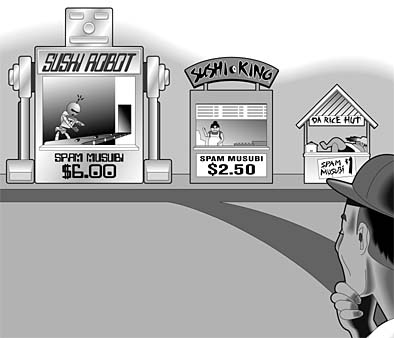

A forum for Hawaii's
business community to discuss
current events and issues
» Pricing psychology » Monkey with the status quo
BACK TO TOP |
PRICING PSYCHOLOGY
KIP AOKI / KAOKI@STARBULLETIN.COM
Figuring a fair price
Consider the following situation based on a well-known pricing experiment. Suppose the two of us are at the beach and getting very thirsty. I offer to go and get us a cold drink at a nearby resort hotel, if its not too expensive. So I ask you, "What is the most you think I should pay?" (Think of an answer.) Now assume the same situation, we are on the beach and thirsty, but instead of a nearby resort hotel, there is only a small, run-down grocery store. What would be your answer to the "what is the most I should pay" question? (Again, think of an answer). When this experiment was conducted a few years ago, people felt that $1.50 was a fair price for a drink from the grocery store, but it was okay to spend $2.65 for the same drink from a resort hotel (approximately 77 percent higher price from the hotel). Why the difference?
From a psychological perspective, what constitutes a fair price depends on the situation. We might forgive a higher price from a fancy hotel because we feel that they have a larger investment and need to charge more. This illustrates one of the basic principles of price fairness -- dual entitlement. According to this principle, we feel that the business is entitled to a fair profit, but as consumers, we are entitled to a reasonable price.
We tend to feel the same way about price increases. A price increase is not automatically seen as unfair, it can be viewed as justified if the increase is thought to be the result of higher costs and not simply an attempt to make higher profits. The classic example is that we will forgive a price increase on snow shovels if it is due to the increase cost of wood handles, but not if it is due to a big snowstorm.
However, we may not be willing to give the benefit of the doubt to all companies.
It has become popular to react harshly to a price increase from a "nasty" oil company. On the other hand, we may forgive a "nice" company such as Coca-Cola or Disney. So rule number one for marketers is to communicate their cost increases to their customers to justify increases in price. The seller's motive can influence our psychological perception of fairness.
Another psychological influence relates to the type of product. If we feel that a product is a necessity, or one we have simply gotten so used to having that we would not like to do without it, we are more likely to judge a price increase as unfair. We hate rent increases and price hikes on prescription drugs, but we are less harsh toward price increases on discretionary products.
Tips for business
Marketers can attempt to influence our perceptions of fairness by doing the following:
1. If you must raise prices, explain to us why the increase is necessary. Shell gas stations in Hawaii have signs on the pumps that tell us that 51.5 cents on every gallon is due to gas taxes.
2. When raising prices, look for other benefits to provide to the customer. A landlord might accompany a rent increase with the announcement that apartments will be painted or a playground will be added.
3. Replace volume discounts and coupons with a rewards program. Studies have shown that 70 percent of the times that we use a coupon, we would have bought the product anyway at the regular price. (By the way, the first grocery coupon, worth 1 cent, was offered by Grape Nuts cereal in 1895.) Reward programs seem fair and have the added benefit of increasing customer loyalty. After losing $50 million in 1979 on a 50 percent off coupon program, American Airlines dropped the discount coupon and launched the airline industry's first frequent flyer program.
4. Reduce or eliminate a discount rather than raising a price. We don't feel as bad about having less of a benefit, after all, we really haven't lost anything. But a price increase seems like a loss and we react negatively.
5. Don't be the first to raise your price. We give a break to those that are perceived to be simply following the competition. Remember the often-used excuse when we were kids "he started it!"
6. When charging a different price to different groups (segmented pricing), or different prices to the same customer at different times (dynamic pricing), think about whether we, as consumers, will agree that it is reasonable to do so. We don't seem to have a problem with higher airline fares for business travelers, higher hotel rates during peak seasons, or lower movie ticket prices for kids. But when Amazon.com used their computer records to quote higher prices each time the same customer bought an additional product, we soon figured this out and reacted very negatively. One customer found that after buying a DVD for $24.49, the next week he was quoted $26.24 for the same DVD. When he removed the "cookies" (id numbers that identify your computer to a web site) from his computer, the same DVD was now priced at $22.74. After a public outcry, Amazon.com claimed that they were merely conducting an experiment and immediately discontinued the practice.
Ted Haggblom is a marketing professor at Hawaii Pacific University. He is president of PriceLogic Corp. and a director of the Pacific Pricing Institute. He can be reached at 544-0831 or thaggblom@hpu.edu.
BACK TO TOP |
CREATING EXCELLENCE
It’s good to monkey around
with the status quo
You don't have to be a rocket scientist to know that innovative new ideas are the lifeblood of any organization. In today's rapidly changing competitive business world, if you're not steadily moving ahead, you are, in fact, falling behind. It won't be long before your competitors leave you in the dust. However, it also doesn't take a rocket scientist to observe the numerous obstacles organizations put in the way of getting the very innovative new ideas they need.
Think about it for a second. How many times recently have you heard someone [or even yourself!] say, in response to the suggestion of a new and innovation idea, any of the following: "We don't do things that way around here." "We tried something like that a while back and it didn't fly." "That's a really interesting idea, but you'll first have to satisfy Policy X, Y, and Z before we can even consider it."
If you've worked in a large organization (which includes government) you've heard more than your share of these statements, and a plethora more like them. They all reflect a simple truth about how organizational policies begin and get perpetrated that, as the story below points out, even monkeys can understand.
Start with a cage containing five monkeys. Inside the cage, hang a banana on a string and place a set of stairs under it. Before long, a monkey will go to the stairs and start to climb toward the banana. As soon as he touches the stairs, spray all of the other monkeys with cold water.
After a while, another monkey makes an attempt to get the banana with the same result -- all the other monkeys are sprayed with cold water. Pretty soon, when another monkey tries to climb the stars, the other monkeys will try to prevent it.
Now, put away the cold water. Remove one monkey from the cage and replace it with a new one. (Even monkeys experience turnover!) The new monkey sees the banana and wants to climb the stairs. To her surprise and horror, all of the other monkeys attack her. After a second attempt and attack, she knows that if she tries to climb the stairs, she'll be assaulted.
Now, remove another of the original five monkeys and replace it with a new one. The newcomer goes straight to the stairs and is attacked. (The previous newcomer takes part in this hazing with enthusiasm!)
Continue this turnover process (after all, new blood is a supposed good!) and watch as all the newcomers get the same treatment from their teammates (most of whom are not really all that sure why they were not permitted to climb the stairs in the first place or even why they are making life equally difficult for the newest monkey.)
Now, here is the real kicker. After replacing all of the original monkeys, none of the remaining monkeys have ever personally been sprayed with cold water. Nevertheless, no monkey ever again approaches the stairs to try for the banana. Why? Because as far as they know, "that's the way it's always been done around here."
So, if your organization seems not to be getting the variety and number of truly new and innovative ideas it needs to stay ahead of the competition, here's a few simple questions you might want to ask yourself.
>> When is the last time you did a thorough and rigorously honest assessment of all your organization's policies and procedures to see which ones have become out-dated?Why are these questions so vital? Because when it comes to human behavior in organizations, it doesn't take a rocket scientist to know the power of "monkey see, monkey do.">> In what subtle (and not so subtle) ways do people's new and different ideas get 'doused' by you and or your colleagues?
>> When you do bring some new blood on board, how long does it take for those people to look and act just like everyone else?
Irwin Rubin is a Honolulu-based author and president of Temenos Inc., which specializes in executive leadership development and behavioral coaching, communication skill building training, and large system culture change. His column appears twice a month in the Honolulu Star Bulletin. Send questions and column suggestions to temenos@lava.net or visit temenosinc.com.
To participate in the Think Inc. discussion, e-mail your comments to business@starbulletin.com; fax them to 529-4750; or mail them to Think Inc., Honolulu Star-Bulletin, 7 Waterfront Plaza, Suite 210, 500 Ala Moana, Honolulu, Hawaii 96813. Anonymous submissions will be discarded.
